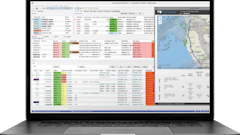
Technology is giving SMBs forward-looking visibility into demand, supply, capacity, and financial trade-offs, allowing them to model scenarios and focus on what matters most.
AI is now amplifying that progress, moving from concept to execution and giving businesses the confidence and clarity they need to make strategic decisions faster. And, these tools are reshaping how companies navigate uncertainty, enabling greater efficiency and stronger control over their supply chains, as outlined in Netstock’s 2025 Benchmark Report.
Key takeaways:
- Two-thirds of SMBs (63%) reported direct operational impacts from tariffs, with most (44%) choosing to absorb costs rather than risk stockouts or lost customers.
- Nearly half of SMBs (49%) still lack a formal rate-locking strategy, while reliance on long-term contracts fell from 47% to 36%, leaving many more exposed to volatility.
- SMBs are exploring new procurement that spreads responsibility across the supply chain: Vendor-managed inventory (VMI) jumped from 29% to 44%, consignment climbed from 19% to 25%, and the share with no alternative strategy fell sharply from 60% to 38%.
- 30% of SMBs now classify a portion of their excess as strategic, potentially frontloaded and stockpiled to hedge against tariffs and disruption. At the same time, 17% report more than 10% of inventory sitting unsold for 12-plus months, up from 12% last year.
- Nearly half (46%) of SMBs reported service levels above 90% (up from 41% in 2024), while 93% launched or expanded product lines in 2025 despite headwinds.
- Almost half chose to absorb (44%), signaling a willingness to accept slimmer margins in order to keep shelves stocked and customers satisfied. In other words, service levels took precedence over short-term cost relief. Only about a quarter of SMBs weren’t impacted, reinforcing how widespread this pressure has become.
- The share of SMBs without a formal hedging or contracting strategy climbed to nearly half (49%), a sign that many are still exposed to supplier price swings. Long-term contracts, while still the most common tool, slipped from 47% to 36%. Forward cover nudged up (11% → 15%), suggesting a small but growing cohort of businesses experimenting with more sophisticated financial protections. The broader picture: a sector navigating volatility with mixed levels of preparedness.
- In 2025, split sourcing, the most flexible model, dropped from nearly half of businesses (47%) to just 38%. Offshore reliance eased slightly (31% → 28%), while domestic sourcing ticked up (19% → 21%). While the shifts are modest, they point to SMBs making firmer commitments that narrow their optionality. This may be the early outline of a reshoring trend, or simply the byproduct of constrained budgets and fewer supplier options. Either way, SMBs are recalibrating sourcing in response to global trade friction.
- Lead time variability remains the top challenge, cited by 68% of respondents. Long supplier lead times follow closely at 58%. Cost, while still important, ranked lower at 48%, up slightly from 43% in 2024. This flat year-over-year pattern on lead times suggests that the pain hasn’t eased. Many SMBs appear to be adapting through buffer stock, improved forecasting, or closer supplier coordination rather than seeing real improvement in supplier reliability.
- Minimum order quantities (MOQs) still weigh on nearly half of SMBs (45%), forcing many to purchase more than they need and tie up cash. Partial deliveries, cited by 26%, have actually ticked up since 2024, showing that order fulfillment consistency continues to challenge day-to-day operations. Together, these responses paint a picture of supply chains where timing and accuracy matter more than ever, and where disruptions translate directly into excess or missed sales.
- Vendor-managed inventory (VMI) jumped from 29% to 44%. Consignment, where suppliers retain ownership until goods are sold, also grew modestly, from 19% to 25%. Perhaps most encouraging is the sharp drop in SMBs without any alternative strategy: down from 60% to just 38%. This signals meaningful progress, with more businesses willing to test shared-risk models and new procurement practices that spread responsibility across the supply chain.
- Global stock turns plateaued in 2025, holding an average of 5.3 and a median of 3.9, almost unchanged from last year. The gap between the mean and median highlights a familiar story: a small group of high performers keep inventory moving efficiently, while most SMBs continue to struggle to accelerate sell-through. Despite the tariff pressures of late 2024, there was no broad improvement in turnover, suggesting that momentum has stalled. For some SMBs, stability may feel like a win, but for others, sluggish stock turns remain a drag on cash flow and competitiveness.
- One in five say less than 10% of their excess is strategic, reflecting leaner, just-in-time philosophies. This wide split highlights two schools of thought: resilience through stockpiling versus efficiency through restraint.
- Total excess and dead stock are both climbing, and dead stock in particular is worsening. Today, 55% of SMBs report holding at least 20% excess stock, up from 48% in 2024. In reality, that percentage may be higher than reported and closer to 40%. Nearly half (46%) say 5% or more of their inventory is dead stock, and 17% carry more than 10%, up from 12% in 2024. That rise is especially concerning: inventory sitting unsold for a year or more ties up cash, eats warehouse space, and drains agility.
- On clearing excess, most SMBs still lean on the most obvious tool: promotions, cited by 69%. Redistribution across warehouses, a tactic that protects margins while moving stock closer to demand, remains underused at just 29%. And 11% admit they have no reduction strategy at all, leaving them exposed when excess becomes unmanageable. These responses suggest that while many businesses are learning to plan strategically on the front end, fewer have developed sophisticated playbooks for clearing the backlog.
- Inventory scale, which had been flattening through 2024 at around $3.5M median value per business, began ticking upward in Q2 2025, reaching $3.6M. That inflection suggests a new round of stockpiling — whether deliberate or reactive — likely spurred by tariff announcements and demand uncertainty. By Q2 2025, however, orders tapered off, and sales spiked again, a sign of businesses discounting to clear shelves after overbuying due to tariffs.
- The 2025 data shows subtle but important shifts in how SMBs approach this question. Reliance on credit fell from 53% to 47%, a decline that likely reflects higher borrowing costs and greater caution around taking on debt. Cash usage dropped even more sharply, from 54% in 2024 to 44% this year, suggesting that fewer businesses are able to self-fund inventory as freely as before. Meanwhile, the share of SMBs with no defined financing strategy climbed to 27%.
- Despite tariff pressures, shifting supplier dynamics, and rising costs, more SMBs are reliably getting products to customers when and where they need them.
- 93% of businesses launched or expanded product lines in 2025.
- AI is no longer just a concept for SMBs; it’s a central tool in inventory management. AI adoption has more than doubled, climbing from 23% in 2024 to 48% in 2025. Future investment plans nearly doubled as well, from 26% to 49%. Just 17% now say they’re unsure of future investment in AI, down from 47% a year ago. The shift signals a decisive move from exploration to execution.
“For SMBs entering 2026, the call to action is clear: treat inventory as the foundation for smarter supply chain planning, embrace AI-driven insights, and use them to unlock resilience, agility, and growth,” according to Netstock.




















